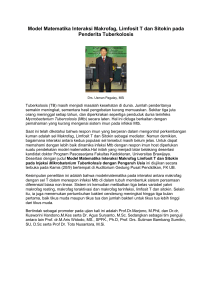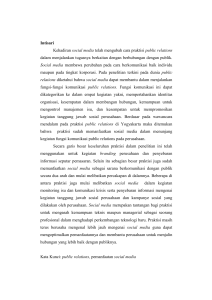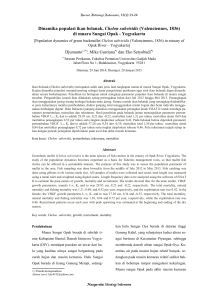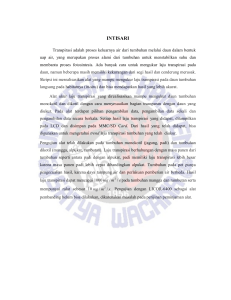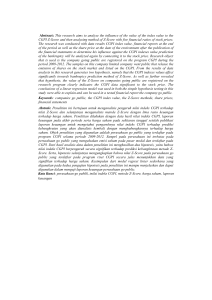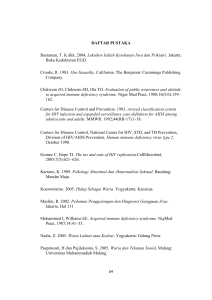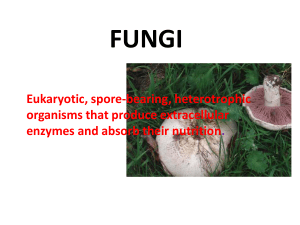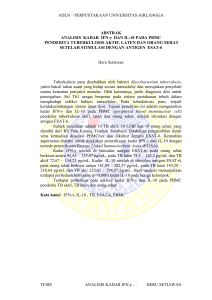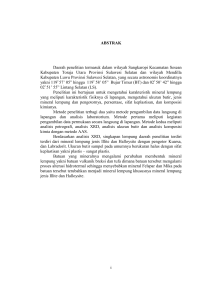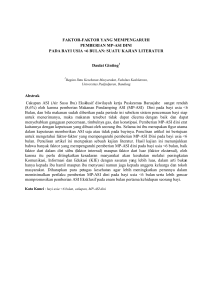Luminal Protozoa
advertisement
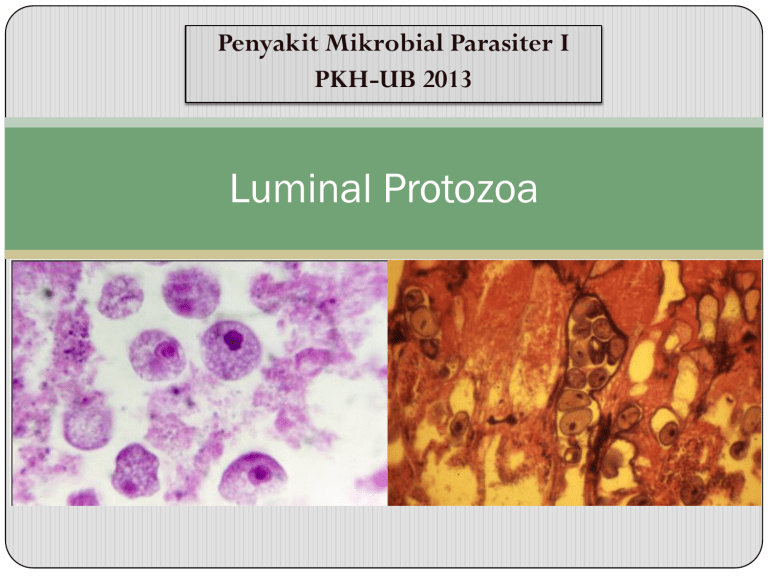
Penyakit Mikrobial Parasiter I PKH-UB 2013 Luminal Protozoa Parasitology terms.. A parasite is an organism that obtains food and shelter from another organism and derives all benefits from this association. obligate parasite, when it can live only in a host; facultative parasite, when it can live both in a host as well as in free form. endoparasites , Parasites that live inside the body whereas those that exist on the body surface are called ectoparasites. Parasites that cause harm to the host are pathogenic parasites while those that benefit from the host without causing it any harm are known as commensals. Parasitology terms.. The organism that harbors the parasite and suffers a loss caused by the parasite is a host. The host in which the parasite lives its adult and sexual stage is the definitive host The host in which a parasite lives as the larval and asexual stage is the intermediate host. Other hosts that harbor the parasite and thus ensure continuity of the parasite's life cycle and act as additional sources of human infection are known as reservoir hosts. An organism (usually an insect) that is responsible for transmitting the parasitic infection is known as the vector. Sarcomastigophora (pseudopodia/flagella) Sarcodina (amoeboid) Mastigophora (flagella) Protozoa Apicomplexa (gliding, intracellular) Ciliophora Microspora Eucoccidiorida (epithel cells) Piroplasmorida (blodd cells) Haemosporida (blood cells) Kinetoplastorida (hemoflagellata) Diplomonarida Trichomonadorida (intestine flagellates) INTESTINAL PROTOZOA Pathogenic Entamoeba histolytica Balantidium coli Giardia lamblia Dientamoeba fragilis Cryptosporidium parvum Enterocytozoon bieneusi Septata intestinalis Cyclospora cayetanensis Isospora belli Commensal Entamoeba hartmani Entamoeba dispar Entamoeba coli Endolimax nana Iodamoeba bütschlii Chilomastix mesnili Trichomonas hominis Blastocystis hominis INTESTINAL AND UROGENITAL PROTOZOA Intestinal and luminal protozoa pada manusia dan hewan Entamoeba histolytica (Amoebae) Balantidium coli (Ciliates) Giardia lamblia and Trichomonas vaginalis (Flagellates) Cryptosporidium parvum and Isospora belli (Sporozoa) Protozoan infections in animals may be caused by organisms in the sub-class Coccidia (disease: Coccidiosis) amoebiasis (amebic dysentery, amebic hepatitis) Causal agent : Entamoeba hystolitica Phylum: Sarcomastigophora Subphylum: Sarcodina Family: Entamoebidae amoebiasis Penyakit: disentri pada manusia, kera, anjing, kucing, tikus, babi Distribusi : seluruh dunia Morfologi : - Bentuk tropozoit (tubuh hospes), ukuran 15-30 mikron - Tropozoit aktif punya vakuola makanan terisi sel darah merah dalam proses digesti - amuboid, memiliki pseudopodia, inti 1 - Pembelahan biner (binary fission) nukleus The fine granular endoplasm may contain ingested erythrocytes amoebiasis - Bentuk kista : bulat dgn dinding tebal, inti lebih dari 1 (1-4 nuklei), badan kromatin padat, di luar hospes - Encyst:To take the form of or become enclosed in a cyst - Excystation: escape from a cyst or envelope, as in that stage in the life cycle of parasites occurring after the cystic form has been swallowed by the host. Fecal-oral life cycle Excystation Trophozoite Cyst Encystment 1. Passed in feces 2. Non motile 3. Resistant to hostile environment 4. Does not multiply 1 1 1. Metabolically active 2. Motile 3. Multiplies by replication 16 life cycle 1. Ingestion of cyst in the contaminated water and food 2. Excystation occurs in the small intestine. Eight trophozoites produced from one cyst. 3. Trophozoites migrate to large intestine where they multiply or may encyst for excretion 1 2 4. Cysts exit hosts in the stool amoebiasis Predileksi : saluran pencernaan, otak, hepar, paru-paru Hospes : manusia, vertebrata amoebiasis Patogenesa : - Abses pada organ predileksi (otakencephalitis, paruparupneumonia, liver hepatitis) - Jaringan nekrotik - Sekresi mukus berlebihan pada usus diare mukus khas amoebiasis sal. Cerna - Haemorraghi pembuluh darah pada jaringan pecah/rusak amoebiasis Gejala klinis Acute: Frequent dysentery with necrotic mucosa and abdominal pain. Chronic: Recurrent episodes of dysentery with blood and mucus in the feces. There are intervening gastrointestinal disturbances and constipation. Cysts are found in the stool. The organism may invade the liver, lung and brain where it produces abscesses that result in liver dysfunction, pneumonitis, and encephalitis. Amoebiasis pada hewan E. invadens of reptiles is morphologically identical to E. histolytica, but it is not transmissible to mammals. E. dispar is a noninvasive, nonpathogenic amoeba morphologically indistinguishable from the pathogenic species E histolytica Pathology Intestinal ulcers (craters/flasks )are due to enzymatic degradation of tissue. The infection may result in appendicitis, perforation, stricture granuloma, pseudopolyps, liver abscess sometimes brain, lung and spleen abscesses can also occur. Strictures and pseudo-polyps result from the host inflammatory response. Hepar dengan abses karena amoebiasis Intestinal amoebiasis ‘flask shaped’ ulcer amoebiasis Diagnosa : - Pemeriksaan sampel feses (fresh atau swab) langsung / pewarnaan Differential Diagnose : - Giardiasis - Bacterial diarrhea demam tinggi dan leukocytosis GIARDIASIS (lambliasis) Etiology Giardia lamblia (a flagellate) Phylum: Sarcomastigophora Subphylum: Mastigophora Giardiasis Causa : Giardia lambia Predileksi : usus halus Hospes : manusia, kucing, anjing, unggas, kuda, primata dan hewan liar lainnya, beaver (reservoir) Giardia is the most common flagellate of mammals and birds. Its trophozoites are binucleate and have four pairs of flagella. Trophozoites adhere to microvilli of epithelial cells of the small intestine. Morfologi umum : Flagellata, 8 flagella dan 2 axostyles Stadium trophozoit : pipih, ‘half-pear’shape, tidak memiliki mitokondria, 12 to 15 micrometer, 2 nukleus dan 2 parabasal bodies Stadium kista : bulat dgn dinding tebal, inti 4 Giardiasis Infection occurs by ingestion of cysts, usually in contaminated water. Decystation occurs in the duodenum and trophozoites (trophs) colonize the upper small intestine where they may swim freely or attach to the sub-mucosal epithelium via the ventral suction disc. The free trophozoites encyst as they move down stream and mitosis takes place during the encystment. The cysts are passed in the stool. Man is the primary host although beavers, pigs and monkeys are also infected and serve as reservoirs. Giardiasis Patogenesa : Tropozoit menutupi epitel mengganggu absorpsi nutrisi malabsorbsi kekurusan Kerusakan epitel abdominal pain dalam jumlah banyak kolik Diare tidak berdarah atau bermukus, karena parasit tidak masuk ke dalam mukosa usus, hanya menempel berbau busuk dan mengapung di air Giardiasis Gejala klinis : Flatulence Lactose intolerrance Abdominal pain Diare berwarna terang, tanpa darah dan mukus Tidak ada demam Differential Diagnose : - amoebiasis - Bacterial diarrhea Trichomoniasis Phylum: Sarcomastigophora Subphylum : Mastigophora Family : Trichomonadidae TRICHOMONIASIS Etiology Trichomonas vaginalis (a flagellate) Morphology The trophozoite form is 15 to 18 micrometers in diameter and is half pear shaped with a single nucleus, four anterior flagella and a lateral flagellum attached by an undulating membrane. Two axostyles are arranged asymmetrically (Figure 12). The organism does not encyst. Two trophozoites of Trichomonas vaginalis from culture. The four flagella and single nucleus are visible. The dark median rod is the axostyle which is characteristic of the trichomonads Life cycle T. vaginalis colonizes the vagina of women and the urethra (sometimes prostate) of men. Infection occurs primarily via sexual contact, although nonvenereal infections are possible. The organism does not encyst and divides by binary fission which is favored by low acidity (pH > 5.9; the normal pH is 3.5 to 4.5). There is no nonhuman reservoir. Symptoms T. vaginalis infection is rarely symptomatic in men, although it may cause mild urethritis or occasionally prostatitis. In women, it is often asymptomatic, but heavy infections in a high pH environment may cause mild to severe vaginitis with copious foul-smelling yellowish, sometimes frothy discharge (Figure 12). Pathology The organism causes contact-dependent damage to the epithelium of the infected organ. Trichomoniasis in cattle Tritrichomonas foetus Synonym: Trichomonas foetus Predilection site: Prepuce, uterus Hosts: Cattle Life cycle: The trichomonads reproduce by longitudinal binary fission. No sexual stages are known and there are no cysts. Transmission occurs during coitus. Clinical signs : irregular oestrous cycles, uterine discharge, pyometra and early abortion Trichomonas in poultry Trichomonas gallinae Synonym: Cercomonas gallinae, Trichomonas columbae Predilection site: Oesophagus, crop, proventriculus Hosts: Pigeon, turkey, chicken, raptors (hawks, falcons, eagles) Trichomoniasis Trichomonas caviae occurs in the intestines of guinea pigs. Its flagella are readily seen in stained fecal smears Balantidiasis Balantidium coli Phylum: Ciliophora Family: Balantiidae Balantidiasis Balantidiasis Causa : Balantidium coli Predileksi : ileum, sekum Hospes : babi, tikus, sapi, kuda, manusia, serigala, kera Morfologi : Bentuk tropozoit : lonjong seperti kantung, silia di permukaan tubuh, memiliki makronukleus dan mikronukleus Bentuk kista : bulat/lonjong, tidak tahan kering, memiliki makronukleus Balantidiasis Hospes definitive adalah manusia Reservoar adalah babi, tikus dan hewan lain. Cysts (bentuk infektif) menginfeksi melalui makanan tercemar parasit Excystasi terjadi di usus halus, tropozoit membentuk koloni di usus besar Di usus besar tropozoit mengalami pembelahan biner dan masuk ke dinding colon dan multiplikasi Tropozoit membentuk cysta yang keluar bersama feses Balantidiasis Patogenesa : Mampu menembus mukosa perdarahan & abdominal pain Merusak mukosa ulcer Gejala klinis : Diare ( darah dan berlendir ) Nyeri perut Nafsu makan berkurang BB turun Dehidrasi Lebih sering asimptomatis Balantidium coli trophozoites in section of intestine (H&E) Cryptosporidiosis Phylum : Apicomplexa Family : Cryptosporidiidae Subclass: Coccidia Cryptosporidiasis Causa : Cryptosporidium parvum Predileksi : usus Hospes : mamalia, burung, reptil Morfologi : Termasuk dalam koksidia Bentuk pada hospes ookista pada mukosa usus mengandung sporozoit Bentuk bulat dgn 4 sporozoit, dinding tebal Cryptosporidiasis Infeksi melalu ingesti/inhalasi exystation sporozoit masuk ke sel epitel sal cerna pembelahan asexual (schozogoni) merogoni gametogony Microgamon dan makrogamon fertilisasi oocyst Cryptosporidiasis Patogenesa : Penembusan mukosa enteritis Pada pasien immunocompromised (HIV) infeksi saluran pernafasan dan cholecystitis Gejala klinis : Asimptomatis Diare cair dan sering Dehidrasi Pada hewan muda lemah, nafsu makan turun-hilang, subklinis, fatal Isospora belii Phylum: Apicomplexa Family : Eimeriidae Isospora belli is believed to be a valid species which ONLY infects humans causing coccidiosis. Oocysts of Isospora belli. The oocysts are large (25 to 30 µm) and have a typical ellipsoidal shape. When excreted, they are immature and contain one sporoblast (A, B). The oocyst matures after excretion: the single sporoblast divides in two sporoblasts (C), which develop cyst walls, becoming sporocysts, which eventually contain four sporozoites each. Gejala klinis diarrhea, steatorrhea, headache, fever, crampy abdominal pain, nausea, dehydration and weight loss. eosiniphilia Coccidiosis Phylum: Apicomplexa Subordo: Eimeriina Coccidiosis Penyebab: Eimeria sp Ciri: Cysta yang masak mengandung 4 sporokista (1 sporokista mengandung 2 sporozoit) Siklus hidup monoksenosa (1 hospes) Dalam hospes: intranuklear(obligat), pada umumnya pada sel saluran pencernaan atau hepar Predileksi Hepar : pada kelinci, Eimeria stidae Urogenital : pada angsa, Eimeria truncata Proventrikulus, uterus: Eimeria neitzi Sekum : Eimeria tenella Coccidiosis in Animals Coccidiosis is an economically important disease of cattle, sheep, goats, pigs, poultry, and also rabbits, in which the liver as well as the intestine can be affected. In dogs, cats, and horses, coccidiosis is less often diagnosed but can result in clinical illness. Stadium infektif : ookista Masuk ke saluran cerna ookista pecah di ventrikulus sporokista keluar Sporokista masuk duodenum, terpengaruh trypsin dan cairan empedu ujung sporokista menjadi lunak dan aktif Sporozoit keluar Sporozoit masuk ke epitel usus Membulat (tropozoit) inti membelah banyak schizont yang berisi merozoit Merozoit pecah mikrogamon zygot ookista keluar bersama feses Periode prepaten : waktu yang diperlukan saat hospes menelan sporozoit sampai dengan ditemukannya di feses With ingested oocysts moving to the intestinal lining, the life cycle of coccidia begins. Intestinal cells are damaged and in 4 – 8 days, depending on the species, oocysts are shed in the faeces Reproduksi Eimeria bukan tidak terbatas suatu saat akan berhenti karena: Jumlah sel hospes terbatas Adanya faktor imunitas hospes Coccidiosis di Unggas Coccidiosis pada kelinci 2 anatomic forms: hepatic, caused by Eimeria stiedae intestinal, caused by E magna, E irresidua, E media, E perforans, E flavescens, E intestinalis, or other Eimeria spp. Transmission of both the hepatic and intestinal forms is by ingestion of the sporulated oocysts, usually in contaminated feed or water. Healthy rabbit liver (left) with rare congenital anomaly with a double biliary vesicle (arrow) and one liver affected by coccidiosis (right). Portion of rabbit intestine affected by coccidia infestation Faktor yang mempengaruhi patogenesis Eimeria Faktor hospes-parasit Hospes: Umur, pada ayam umur 2-4 minggu. (Ayam umur <2mg masih mempunyai imunitas induk, kekuatan lambung lemah belum bisa memecah ookista). Pada domba/kambing umur 4-6 bulan, sapi 3-6 bulan Jenis parasit tergantung jenis eimeria yang patogen Jumlah ookista yang tertelan Gejala klinis Diare, diare berdarah Lemah, nafsu makan berkurang, berat badan turun Kematian karena perdarahan hebat Toxoplasma Phylum: Apicomplexa Subordo: Sarcocystidae Toxoplasmosis Bersifat zoonosis Heteroksenosa, bisa menginfeksi semua jenis hewan Siklus hidup Siklus enteroepithelial pada hospes intermediate Hospes definitive terinfeksi melalui :: Makan oocyte Toxoplasma (yg telah sporulasi) Makan cysta Toxoplasma yang terdapat pada hospes intermediate (daging domba, sapi, tikus, anjing, burung) Tugas Jelaskan siklus hidup Toxoplasma gondii Patogenesa Penularan Gejala klinis Diagnosa ??
